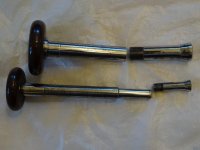I am using a schaublin 70 lathe, where a 8mm collet and it's adaptor is stuck in the headstock.
A project required me to chuck a 0.25mm rod, and I do not have a W12 collet that size.
I got a 8mm watchmaker lathe collet adaptor (forgot where/when i bought it from).
So I decided to "try" this adaptor. This is the first time i used this adaptor.
Basically this "home make adaptor" allow me to chuck a 8mm watchmaker collet onto the schaublin 70.
It is make up of 3 parts. (photos are not real and actual, they are built from my memory)

Currently, the 3 parts adaptor is stuck in the headstock.
The Part A goes in from the handwheel direction, it won't come out.
Part B and C is as seen below, protruding out.

I have tried a method using 3 jaws/4 jaws chuck onto tailstock to grab hold of part B. But it won't grab well, and it "slipping" the part B.
I know the forum has experienced people that may have heard of this problem, i wish to get the advises.
Please assist, thanks.
A project required me to chuck a 0.25mm rod, and I do not have a W12 collet that size.
I got a 8mm watchmaker lathe collet adaptor (forgot where/when i bought it from).
So I decided to "try" this adaptor. This is the first time i used this adaptor.
Basically this "home make adaptor" allow me to chuck a 8mm watchmaker collet onto the schaublin 70.
It is make up of 3 parts. (photos are not real and actual, they are built from my memory)

Currently, the 3 parts adaptor is stuck in the headstock.
The Part A goes in from the handwheel direction, it won't come out.
Part B and C is as seen below, protruding out.

I have tried a method using 3 jaws/4 jaws chuck onto tailstock to grab hold of part B. But it won't grab well, and it "slipping" the part B.
I know the forum has experienced people that may have heard of this problem, i wish to get the advises.
Please assist, thanks.









